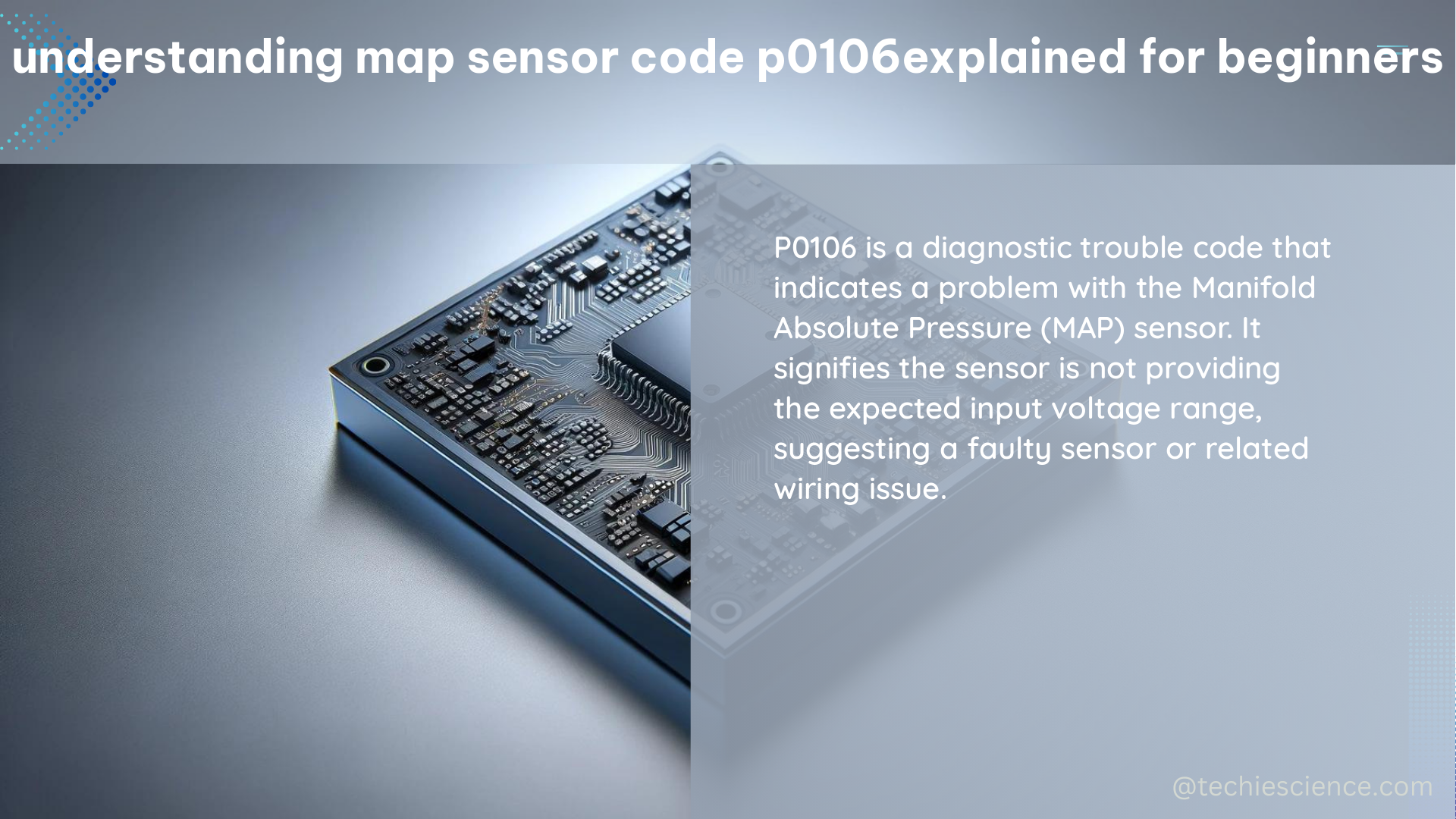The Manifold Absolute Pressure (MAP) sensor is a critical component in a vehicle’s engine management system, responsible for measuring the atmospheric pressure inside the intake manifold. This information is essential for the Powertrain Control Module (PCM) to calculate the correct air-fuel mixture for optimal engine performance. The P0106 diagnostic trouble code (DTC) indicates a problem with the MAP sensor or its associated circuitry, often caused by malfunctioning sensors, electrical faults, or vacuum leaks.
What is a MAP Sensor?
The MAP sensor is a pressure transducer that converts the pressure inside the intake manifold into an electrical signal. This signal is then sent to the PCM, which uses it to determine the engine load and adjust the fuel injection and ignition timing accordingly. The MAP sensor operates on the principle of measuring the absolute pressure within the intake manifold, which varies based on engine load and speed.
Key Functions of the MAP Sensor
- Fuel Injection Control: The PCM uses the MAP sensor data to calculate the appropriate amount of fuel to inject into the engine, ensuring the correct air-fuel ratio for efficient combustion.
- Ignition Timing Adjustment: The PCM adjusts the ignition timing based on the MAP sensor input to optimize engine performance and fuel economy.
- Turbocharger/Supercharger Control: In turbocharged or supercharged engines, the MAP sensor helps the PCM monitor and control the boost pressure, preventing engine damage.
- Barometric Pressure Compensation: The MAP sensor can also be used to compensate for changes in barometric pressure, which can affect engine performance.
Understanding the P0106 Code

The P0106 code is triggered when the PCM detects an issue with the MAP sensor’s input signal. This can occur when the sensor’s voltage output is outside the expected range, indicating a problem with the sensor itself or its associated wiring and connections.
Common Causes of the P0106 Code
- Malfunctioning MAP Sensor: The MAP sensor may be faulty, damaged, or contaminated, leading to an erratic or inaccurate signal.
- Vacuum Leaks: Cracks, disconnections, or other issues with the vacuum lines connected to the intake manifold can cause fluctuations in the MAP sensor’s readings.
- Electrical Faults: Problems with the MAP sensor’s wiring, such as shorts, opens, or poor connections, can result in the P0106 code.
- Barometric Pressure Sensor Issues: In some cases, the P0106 code may be triggered by problems with the barometric pressure sensor, which is often integrated with the MAP sensor.
- Other Engine Issues: Problems with other engine components, such as the Mass Airflow (MAF) sensor, can also affect the MAP sensor’s performance and trigger the P0106 code.
Diagnosing and Fixing the P0106 Code
To diagnose and resolve the P0106 code, follow these steps:
- Visual Inspection:
- Examine the MAP sensor and its associated wiring for any visible signs of damage, such as cracks, corrosion, or loose connections.
-
Check the vacuum lines connected to the intake manifold for cracks, leaks, or disconnections.
-
Vacuum Leak Test:
- Use a vacuum gauge or a smoke machine to check for any vacuum leaks in the intake system.
-
Repair or replace any damaged vacuum lines or components to eliminate potential sources of the problem.
-
MAP Sensor Cleaning or Replacement:
- If the MAP sensor appears dirty or contaminated, clean it using a specialized sensor cleaner.
-
If cleaning does not resolve the issue, replace the MAP sensor with a new, genuine part.
-
MAP Sensor Testing:
- Use a multimeter or a dedicated sensor tester to measure the MAP sensor’s voltage output at different engine speeds and loads.
-
Ensure that the sensor’s voltage readings are within the manufacturer’s specified range.
-
Intermittent Issue Diagnosis:
-
If the P0106 code appears intermittently, monitor the sensor’s performance over time and under various driving conditions to identify any patterns or triggers.
-
Checking for Other Engine Issues:
-
Inspect and test other engine components, such as the MAF sensor, that can affect the MAP sensor’s readings and potentially trigger the P0106 code.
-
Trouble Code Clearing and Road Testing:
- After making any necessary repairs or replacements, use an OBD-II scanner to clear the P0106 code from the vehicle’s computer.
- Take the vehicle for a test drive to ensure the issue has been resolved and monitor for any recurrence of the code or associated symptoms.
By following these steps and addressing the root cause of the P0106 code, you can effectively diagnose and fix the problem, restoring your vehicle’s engine performance and fuel efficiency.
Reference:
- P0106 Code: Manifold Absolute Pressure (MAP) / Barometric Pressure Circuit Range/Performance Problem
- P0106 Code Explained: MAP Sensor Problems
- Diagnosing and Fixing the P0106 Code
- P0106 Code: Manifold Absolute Pressure (MAP) / Barometric Pressure Sensor Range/Performance
- Making Sense of Your Sensors: MAP Sensor

The lambdageeks.com Core SME Team is a group of experienced subject matter experts from diverse scientific and technical fields including Physics, Chemistry, Technology,Electronics & Electrical Engineering, Automotive, Mechanical Engineering. Our team collaborates to create high-quality, well-researched articles on a wide range of science and technology topics for the lambdageeks.com website.
All Our Senior SME are having more than 7 Years of experience in the respective fields . They are either Working Industry Professionals or assocaited With different Universities. Refer Our Authors Page to get to know About our Core SMEs.